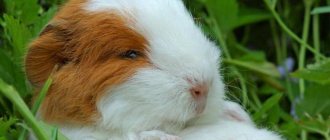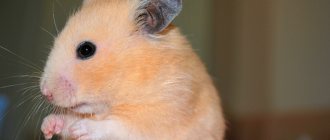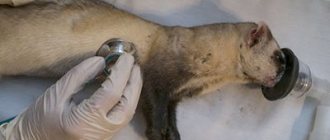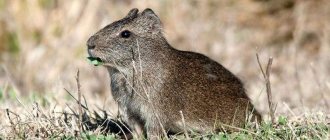What is the life expectancy of guinea pigs? How long do rodents live and what factors influence the timing? Proper care of your pet. How to arrange a rodent's home. Mandatory procedures. Proper nutrition. How to avoid mistakes when caring for a guinea pig.
When we get a pet, we try to provide it with everything it needs to be healthy, happy and live a very long time. Regarding guinea pigs, these domesticated rodents boast a long lifespan compared to others.
Of course, many factors influence their lifespan, but a person can create the right living conditions, provide adequate nutrition, and organize proper care, which will prolong their life.
Next, we will take a closer look at how long guinea pigs live, what affects the duration, how to avoid mistakes in care and maintenance, and how to create favorable conditions for a long life.
average life expectancy
First of all, it is worth saying that these cute animals among all types of rodents are recognized as real long-livers. This factor certainly influenced the enormous popularity of these animals as pets. Nobody wants to buy an animal, get used to it, fall in love with it, and after a short time say goodbye forever.
We can compare the lifespan of another popular pet - hamsters, it is 3-4 years, while guinea pigs live on average 5-8 years.
The funny little animal is considered young, in the prime of life until the age of 4 years, but after 6 years old age sets in. In natural conditions, they encounter a large number of predatory enemies, so they often do not live a long life.
At home, a person creates comfortable and safe conditions, which certainly contributes to a longer life.
As already mentioned, if you create all the necessary conditions for the animal, it will please its owners with good health and a long life, celebrating its 10th anniversary with you.
Rarely, but still there are long-livers who cross the threshold of 12 years. A guinea pig lived in England, which only two months did not live to the age of 15 years and was included in the Guinness Book of Records as a real centenarian.
Factors influencing duration
There are factors that, to one degree or another, can influence the duration, including:
- Guinea pig breed.
- Conditions of detention.
- Care.
- Nutrition.
- Health.
- Heredity.
It is impossible to take into account only some factors and ignore others; each of them requires maximum human attention.
Animal Species
Friendly pets differ in color and fur length. Among them are the following colors:
- tortoiseshell;
- agouti;
- Dutch;
- 2 or 3 colors;
- Himalayan;
- Dalmatian;
- self.
Among the short-haired rodents, the following breeds are distinguished: Abyssinian, Rex, American (English), Teddy, Crested, Ridgeback. Among the long-haired representatives, there are Silk or Sheltie, Texel and Peruvian breeds. There are rodents that have no hair at all - Baldwin and Skinny.
Breed influence
So, this factor, of course, cannot make any adjustments to the deadlines, but it initially determines the set deadlines that the owner can focus on.
We have already said that this representative lives longer than other rodents, and it is also worth saying that some breeds live longer than others.
Breeds that were formed naturally, namely in natural conditions, are more tenacious than those that were bred artificially.
The fact is that when formed in a natural way, the rules of natural selection apply and only the strongest individuals remain.
There are a large number of breeds, there are about 50 of them. Each breed has its own characteristics, they differ in size, color, coat, character and other parameters.
All breeds are divided into groups:
- Short-haired.
- Long-haired.
- Hairless.
The last group, hairless rodents, refers to individuals with the shortest lifespan. The average lifespan is 5 years; with proper maintenance and care, they can live a maximum of 8 years. These animals include the Skinny and Baldwin breeds.
They were bred artificially by breeders and are considered hypoallergenic breeds. Lack of fur certainly leads to frequent colds and illnesses.
Once these breeds were obtained, their life expectancy was the same as that of hamsters, but breeders tried to improve this species as much as possible and managed to extend it.
The owners of the longest life are the short-haired representatives. These little animals live up to 7-8 years and these are average figures.
These breeds include:
- Himalayan.
- American.
- Rex, royal.
- Crested.
- American Teddy
- Texel.
Relatively long-haired, their average life is 6-7 years, but proper care provides longer years.
These representatives include the following breeds:
- Sheltie.
- Peruvian.
- Rosette.
- Coronet.
The figures presented above are only a guideline; you cannot rely on them alone; other factors must be taken into account.
Longevity records
With proper and careful care, pigs can live up to ten years. The record holder in terms of longevity are individuals who have lived up to fifteen years. But in ordinary life it is better to forget about records and completely focus on the happiness and health of your animal, then a long life is guaranteed.
Conditions of detention
You can’t just buy a cage, put an animal in it, and think that if you feed it on time, the animal will be completely happy, because this is more like a prison sentence.
Proper content includes a huge number of important points that will make the animal happy and healthy.
First of all, you need to make sure that the cage is spacious, that the necessary accessories are installed in it, and that there is enough free space.
Clean the cage regularly to ensure it is always clean. Change the filler and bedding, wash the tray and all accessories at least once a week. Fillers and fillers must be of high quality.
There must be an equipped area that will allow your favorite animal to have an interesting and fun time. Tunnels and other entertaining toys are installed here.
Remember that in addition to a good mood, they bring health benefits, since they will move more and will not gain excess weight, which happens quite often.
Remember that they should be allowed out of their cage for walks. Let them run around the apartment as often as possible, but ensure complete safety. In warm weather, you can take a walk outside.
The temperature in the room where the animal is kept should be 18-22°. Avoid any drafts, they can get cold very easily.
If you choose a hairless pig, remember that due to the lack of fur, they need a higher room temperature of 22-24°, otherwise they will get sick.
Caring for babies without a nursing mother
If a guinea pig dies during childbirth or abandons her babies, it is very difficult for the babies to come out. The best option is to find them a wet nurse. If you have a pig that has recently given birth, you should try to introduce someone else's litter to it.
The female is more likely to accept cubs that are not her own if she smells a familiar odor coming from them. Therefore, each baby is rolled in stuffing from the foster mother’s cage. The female is placed in a carrier for an hour and a half. Strangers are placed in the nest with the native cubs. After this, the nurse is returned to the cage.
If a nurse cannot be found, the owner of the rodent family will have to care for the brood. The very first thing to do is to protect the little piglets from the cold. A heating pad placed directly in the cage will help with this.
For artificial feeding you will need an insulin syringe without a needle and cream with a fat content of 10%. In the first 3 days after birth, piglets are fed every 2 hours around the clock. On the 4th day, the break between meals is increased to 3 hours. The baby is picked up and held in a column.
Milk is introduced into the mouth very slowly so that the baby does not choke. The initial feeding dose is 0.5-0.7 ml. As the pigs get older, the serving size will increase.
From the 4th day, baby guinea pigs can try new foods:
- carrot;
- apple;
- zucchini;
- dairy-free baby cereals.
Care
Proper care for your guinea pig will not only ensure ideal appearance, good health and well-being, but will also prolong its life. The animal cannot fully take care of itself on its own; it needs human help.
In natural conditions, grinding down of teeth and claws occurs naturally when they get food for themselves and dig holes. At home, in captivity, these processes are absent, so you need to monitor the condition of the teeth and trim the claws.
To grind down their teeth, they are given branches of fruit trees and shrubs, and a special mineral stone is also placed in the cage. If the teeth are too long and problems with nutrition appear, without taking any measures, the rodent will stop eating altogether, which will lead to exhaustion and death. Be sure to undergo examinations by a veterinarian and, if necessary, he will carry out a grinding procedure.
Claw trimming is also carried out regularly. Too long nails prevent you from standing up on your paws normally, interfere with eating and walking, and also lead to curvature of your fingers.
To trim the claws, use a nail clipper; the overgrown part is cut off; you should be careful not to damage the blood vessel that is located inside the nail.
Mandatory procedures include cleaning the ears and examining the eyes. Inspect the ears regularly, if wax is present, using a cotton pad, which is moistened in a special solution and carefully removed.
Also, if there is dirt, the eyes are carefully wiped. It is necessary to monitor the condition of the fur; long-haired dogs should be combed regularly using a special comb and brush.
Regarding bathing, water procedures are not mandatory; it is stressful for the rodent. You should resort to bathing only when absolutely necessary, when the fur cannot be cleaned or the dirt cannot be washed out. If you do bathe your pet, you will need to strictly adhere to the rules of procedure.
You need to buy a special shampoo, before and after bathing, avoid drafts and coolness. After bathing, wrap it in a towel and wait until the fur is completely dry, only then let it go. Some people use a hairdryer to dry the little animal, but not everyone is okay with such a noisy unit.
Nutrition composition
A very important component of a healthy life for a guinea pig is nutrition. This animal is forbidden to starve, not because the body needs nutrients, but because these animals lack peristalsis.
This feature is that processed food can leave the intestines only if new food arrives, in other words, a new piece of food pushes through the already processed one.
But you should be very attentive and careful, you cannot leave them hungry, but it is also prohibited to overfeed them, because this can lead to obesity, which is also dangerous for the animal.
Therefore, you need to approach the organization of your diet as responsibly as possible, adhering to the daily nutrition standards:
- 60% is feed.
- 20% - vegetables and fruits.
- 20% - hay, branches of fruit trees, crackers.
We must not forget about vitamins and minerals. The animal must always have clean water.
How many years do guinea pigs live?
Guinea pigs are extremely popular among children - charming domesticated rodents the size of a dwarf rabbit or puppy. However, among adults there are also many fans of caves (Guinea pigs) - this is what breeders most often call their pets.
Wonderful companions, very unpretentious and capable of competing in attractiveness with handsome cats or pocket dogs, guinea pigs can easily remember not only their name, but also many commands.
General health
These animals have a fairly strong immune system; with proper maintenance and care, they can boast of good health. But despite this, rodents, just like others, are susceptible to diseases and it is necessary to monitor any changes in their behavior and appearance.
If you notice any changes, for example, your guinea pig has stopped being active, has lost its appetite, has a cough, it itches a lot, its fur has begun to fall out, and other symptoms, you should immediately go to the veterinarian.
Remember that the disease is easy to treat at an early stage. Advanced disease leads to various severe complications and even death.
Be sure to undergo regular checkups with a veterinarian and get vaccinated. There are diseases that do not show any symptoms in the early stages; examination by a doctor will allow them to be identified in time.
How to find out age
Of course, it is better to purchase an animal at an early age in order to know exactly in what conditions it grew, how it was kept and what it ate.
But there are situations when they buy adult rodents, in which case it is not possible to determine the exact age, but it is quite possible to recognize a young or older animal.
So, you need to pay attention to the following indicators:
- Activity. It is very difficult for young individuals to sit still, they are interested in absolutely everything around them, they run and fuss. Old age requires peace and quiet; at this age rodents are less active.
- Weight, dimensions. The small animal weighs about 0.5 kg; by the age of 1.5 years, females already weigh 0.7-1.0 kg, and males 1-2 kg. The body length of an adult animal is about 27-29 cm.
- Wool. A young animal's fur is fluffy, soft and very beautiful; with age, small bald patches form; the more of them, the older the rodent. But remember that the condition of the coat is affected by the presence of diseases.
- Teeth. Juveniles have very white, sharp and strong teeth; they can easily handle solid food. Older animals' teeth have a yellow tint; it is more difficult for them to cope with large and hard pieces of food, and their teeth wear down unevenly.
- Claws. You should pay attention to the claws of the hind legs; in young animals they are smooth and well sharpened; in old animals they become crooked and rather blunt.
Table of the age of a rodent by human standards
The rodent's body develops very quickly; 1 year of life for a guinea pig is equivalent to 10-15 years for a human. In the table we can see the relationship between the age of a pet and the age of a person.
| Pig age | 2 weeks | 6 months | 2 years | 5 years | 7 years |
| Person's age | 6 months | 6.5 years | 26 years | 65 years old | 91 years old |
These are approximate indicators; individual parameters should always be taken into account.
Training and games
Active rodents love to play. Their house should have different facilities for running, jumping and climbing. If there are several pigs in a cage, they should have plenty of space to hang out together.
Guinea pigs are very smart animals. They can learn to perform simple tricks. Fluffy rodents love to communicate with their owners and actively make contact. They can spin around, jump over a bar, sleep in a hammock, and sit on your shoulder. To cheer up your pet, give him a small treat.
How to extend the life of a pet
From the moment an animal appears in a person’s home, all responsibility for its life and health rests with the owner. He needs to create all the conditions for the animal to be happy and healthy; it needs care and love. In fact, it is not that difficult, the main thing is to have the desire.
As already mentioned, the factors that will extend life, proper maintenance, nutrition and care, depend entirely on the person. When organizing meals, you need to remember that they get all the nutrients from food.
The diet should be properly balanced and not contain harmful foods. The older the animal gets, the more attention and care it requires; you need to monitor its health, pay more attention to its teeth and claws.
They are very shy and impressionable, protect them from stress and noise. Avoid drafts and hypothermia. Give them time, don’t let them get bored, play, hold them, talk to them.
In the case when the owner does not have free time, get him a friend, another rodent. Remember that males are competitors and should not be housed together. They will quarrel and even fight for their territory.
Be sure to undergo preventive examinations with a veterinarian. Doctors will prompt and recommend the necessary actions or procedures if a problem is noticed, which will allow it to be eliminated at the initial stage.
Who are guinea pigs
The origin and domestication of these rodents has a long history . It is believed that they began to be tamed back in the 5th century BC. In South America. Some tribes worshiped pigs, others used them as food: cave meat is considered a delicacy and tastes similar to rabbit meat. In Peru, guinea pig dishes are still on the menu of many restaurants.
Article on the topic: When, how much and how do guinea pigs sleep?
Good-natured herbivores, with little ability to defend themselves, were easy prey. But their unusual appearance captivated the colonialists, who began to import funny animals to Europe. Soon even royalty acquired pigs, and breeders began serious work on breeding more and more new breeds.
The name rodents causes a lot of controversy among scientists, because the animals do not know how to swim, are clean and eat only plant foods. There are many versions, the most common of which is that the name comes from the abbreviation of the word “overseas”, that is, brought from overseas.
This family of rodents was called pigs, apparently, because of the sounds that the animals often make: they often grunt, although they can grumble, growl, whistle and imitate some birds. With their short neck, body proportions, and head structure, they are also very similar to ordinary piglets.
This is interesting! Among the varieties there are breeds; individual representatives, for example, the Peruvian Cui, can reach a height of 45 cm and a weight of up to 4 kg. But the most common guinea pigs weigh no more than 1 kg, and their body length is up to 35 cm.
Today, pigs are often recommended as first pets for older preschoolers and primary schoolchildren. Similar to soft toys, they do not require careful care and supervision, but they make children feel responsible for the life and health of their “little brother.”
They learn to care for living beings and find contact with them. Parents like that they don’t have to walk their pet 2-3 times a day, clean up endless piles and puddles, and wait for unpleasant surprises after returning home in the form of torn curtains and torn clothes and shoes.











